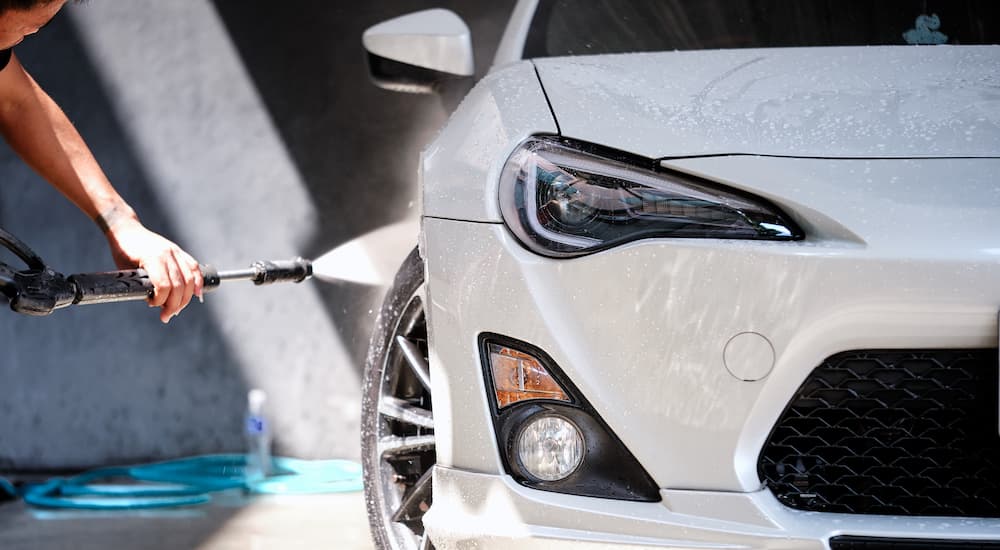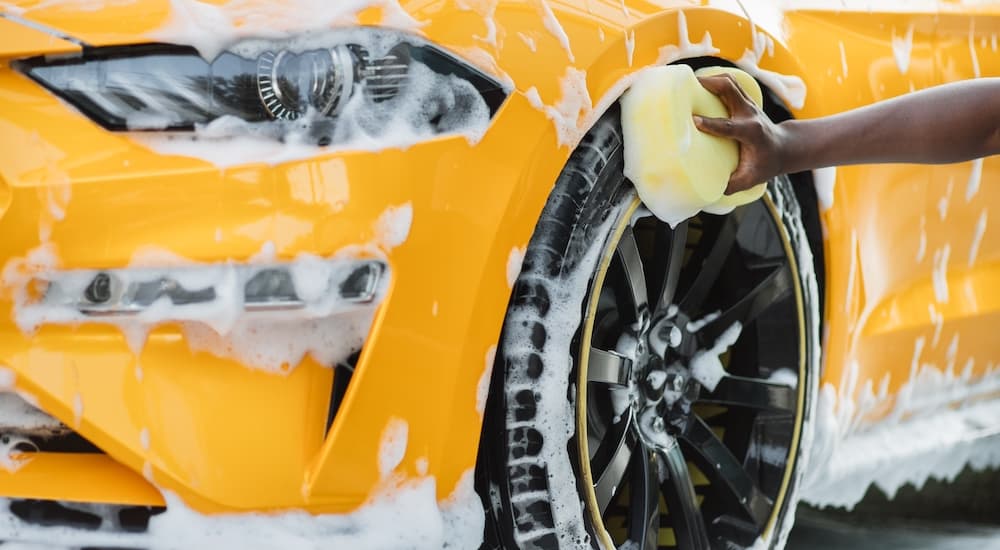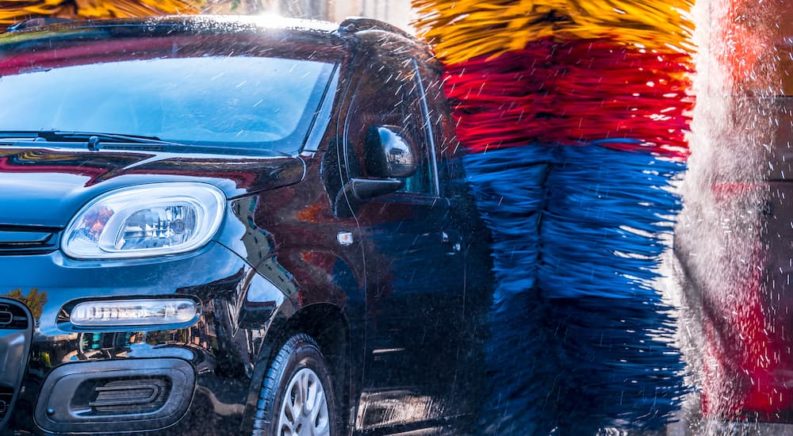When it comes to protecting your car from the elements, picking the right type of car wash is important. From self-service bays and automated car washes to full-service car detailing operations, there are countless options on the market claiming to be the best, but how do they stack up? Some drivers might prioritize speed and convenience above all else, while others might put more value on a deep, thorough cleaning that offers long-lasting protection. Does your vehicle deserve the automotive equivalent of a full spa treatment, or is a quick rinse in the shower more your speed? Ultimately there’s no one right answer, and it often comes down to a matter of taste––and budget. We’ll take a look at some of the most popular types of car washes and run down the advantages and disadvantages of each. We’ll also discuss why developing a regular car washing habit is important and how often the task should be performed. Roll up your sleeves, grab your squeegee, and join us as we compare different car wash options.
Why Clean Your Car Anyway?
Keeping your vehicle tidy is about more than cleanliness; it’s one of the easiest ways to ensure that your car retains its value and earns you the best possible return on investment when it comes time to sell or trade it in for a new model. While vehicle maintenance, accident history, and other details are all important factors that a potential buyer might consider, there’s a lot to be said for curb appeal. First impressions are everything, and giving your vehicle the once-over at a quality car wash can make the difference between landing a sale and placing yet another classified ad.
Even if you’re not planning to sell anytime soon, there are good reasons to keep your vehicle as clean as possible. A spotless ride can help prevent distractions behind the wheel, and it’s easier to quickly pick out new dents, dings, and other cosmetic issues when working with a clean slate. Most importantly, regular cleaning will help avoid more significant problems and prevent corrosion, paint damage, and other issues from spiraling into big-ticket repairs. It’s also important not to discount the peace-of-mind factor. While you might not give your vehicle’s appearance much thought on a daily basis, there’s a lot to be said for the old maxim “clean house, clean mind.” Keeping your ride looking good can go a long way in improving your mental state while giving you a sense of pride.
Before we start comparing the various types of car washes, we should briefly discuss one of the most important factors when cleaning your vehicle: frequency. There’s no hard-and-fast rule regarding how often a driver should wash their vehicle, though most experts advise hitting it with a hose once a month at a minimum. This schedule might need to be accelerated for those living in areas with harsher weather conditions or an abundance of dust, though there are a few ways to give yourself a little extra time. First, store the vehicle inside whenever possible, reducing exposure to the elements. Second, splurge for a wax coating at the end of every cleaning session. This protective film will help repel dirt, water, and other contaminants, doubling the amount of time you can go between washes.

Self-Service Car Wash
For those who prefer the DIY route, self-service car washes are one of the most affordable options. A self-service car wash will provide you with all the tools you need to get the job done, including soap, wax, brushes, and a high-pressure hose. Unlike many other types of car washes, which will have drivers choose a specific package for a set rate, a self-service car wash will typically have you pay by the minute. Depending on how thorough you want to be, a self-service car wash could end up costing anywhere between $3 for a quick rinse and over $10 for a good, deep cleaning.
The self-service car wash bay will usually feature a sprayer that can dispense any number of car cleaning products, from wheel and tire cleaner to a pre-soak solution, high-pressure soap, wax, and simple water. Drivers can choose how many treatments to apply based on their budget and schedule, making a self-service car wash one of the most customizable options. Self-service car washes are a great choice for city dwellers or those who don’t have access to a hose at home, though there are some drawbacks. Self-service car washes usually lack a way to dry your vehicle, which can result in some pesky, uneven drying patterns following the wash.
Automated Car Wash
Automated car washes are among the most popular and convenient options for drivers seeking a fast, easy alternative to the self-service option. They’re only a little more expensive than self-service car washes––around $6 to $10 on average––and if you’re savvy when it comes to loyalty programs and coupon clipping, you’ll probably be able to score a free wash every now and then. Extra services like undercarriage cleaning, waxes, and other treatments will usually cost a little more, but the added protection is worth the cost. Unlike self-service car washes, automated options often finish up with a drying cycle at the end, which can be important if you’re looking to avoid uneven drying patterns. The term “automated car wash” actually encompasses a variety of designs, so let’s break each of those down quickly.
Bay vs Tunnel
These two terms largely refer to the way a driver moves through an automated car wash. In an in-bay automatic car wash, drivers pull the vehicle up to a designated spot and stay put while all the machinery whizzes around them, soaping up the vehicle, scrubbing it down, rinsing it off, and finally, giving it a good blow dry. When the cycle is complete, drivers are given the green light and then sent on their way with a sparkling-clean vehicle.
On the other hand, tunnel car washes use a conveyor belt to move the vehicle through the wash at a predetermined speed. They’re not much different from in-bay automatic car washes when it comes to the services offered, though some drivers prefer the tunnel option thanks to its speed. In an in-bay car wash, each driver has to wait until the customer ahead of them has completed the entire cleaning cycle, but a tunnel car wash can get one vehicle started before the one ahead of it has finished, leading to decreased wait times. One area where tunnel car washes don’t have the advantage is cost. Compared to in-bay automatic car washes, the tunnel option is usually more expensive due to the cost of keeping the mechanical conveyor system in tip-top shape.
Soft-Touch vs No-Touch
Another important distinction in the world of automatic car washes is the soft-touch versus the no-touch approach. A soft-touch car wash uses clothes, sponges, and other devices that come in contact with your vehicle. On the other hand, no-touch car washes use high-pressure water and soap to get the job done. Some drivers say that a soft-touch car wash is a more effective option, but it comes with some risks. No matter how softly they’re touching the vehicle, the brushes can potentially damage exterior parts like mirrors or antennae. If the bruises aren’t thoroughly cleaned between washes, they can cause the grit and grime from the previous customer to scratch up your paint job.
Hand Car Wash
If money––and time––are no object, it’s hard to do better than a professional hand car wash. Trained professionals will go over every inch of your vehicle, hitting areas that automated car washes simply can’t and relying on their expertise to address little-known trouble spots where dirt, grease, and grime love to hide. It’s far from the cheapest option, with even the most basic service costing upwards of $20, but it can provide a lot more peace of mind than if you decide to take your luxury car through an automated car wash. Not only will you get that human touch, but you’ll also be able to eliminate the risk of scratches, scrapes, or any other damage that might occur with the automated approach. A hand car wash is one of the slowest options, though many outfits offer customers a comfortable waiting room to cool their heels while their vehicle gets its makeover. In addition to treating the outside of the vehicle, many professional hand car washing operations will also offer an interior detailing service.

Waterless and Rinseless Car Washes
Lastly, we’ll run down two at-home alternatives to the typical commercial car wash: waterless and rinseless car washes. Available at most auto parts stores, a waterless car wash is a spray mixture that is applied to a vehicle’s body panels and then simply wiped away with a clean cloth. It’s a great alternative for drivers who don’t have access to a hose or those living in areas with restricted water usage, though it’ll never get a vehicle as clean as a good old sponge and a bucket of suds.
A rinseless car wash also helps drivers to limit their water usage, though it does require at least two gallons to get things going. Simply add the rinseless car wash of your choice to a bucket, wet a microfiber cloth in the solution, and apply it to the vehicle. Unlike a regular car wash soap, which requires a thorough rinsing cycle, a rinseless car wash can be dried off using another microfiber towel, saving drivers time––and water––while providing a serviceable clean.
Get Into the Cleaning Routine
Picking the right type of car wash can make all the difference when it comes to keeping your vehicle looking its best. Hopefully, this guide will come in handy the next time you notice your vehicle looking a little worse for wear. Remember, getting into a good car washing habit can have a significant impact when it comes to your vehicle’s value. This is especially relevant for those looking to put their vehicle on the market in the near future. While we might want to convince ourselves otherwise, a buyer can usually tell the difference between a vehicle that has been lovingly cared for throughout its life and one that saw the inside of a car wash for the first time just hours before it went up for sale. We’re not saying that you need to pamper your vehicle or obsess over its cleanliness, but you might be surprised by how much of a difference a good cleaning routine can make.

